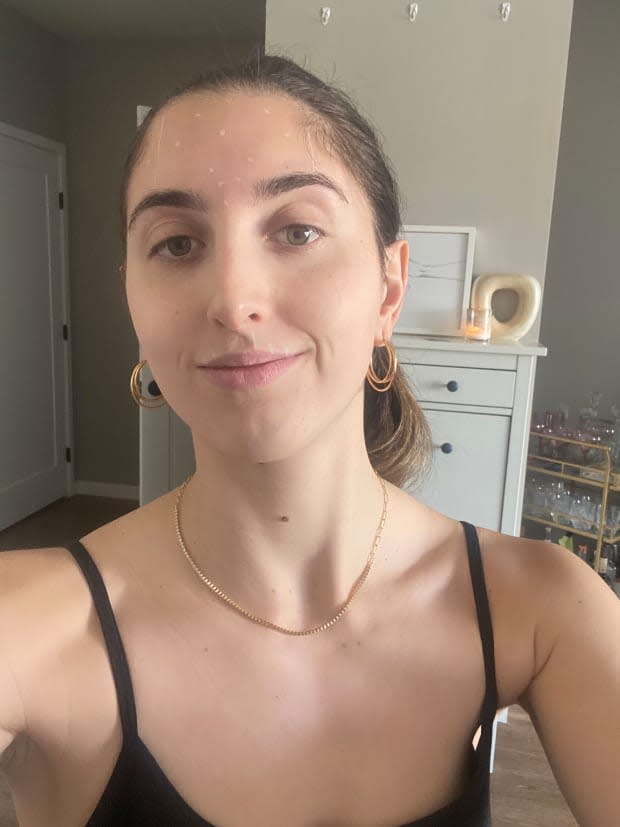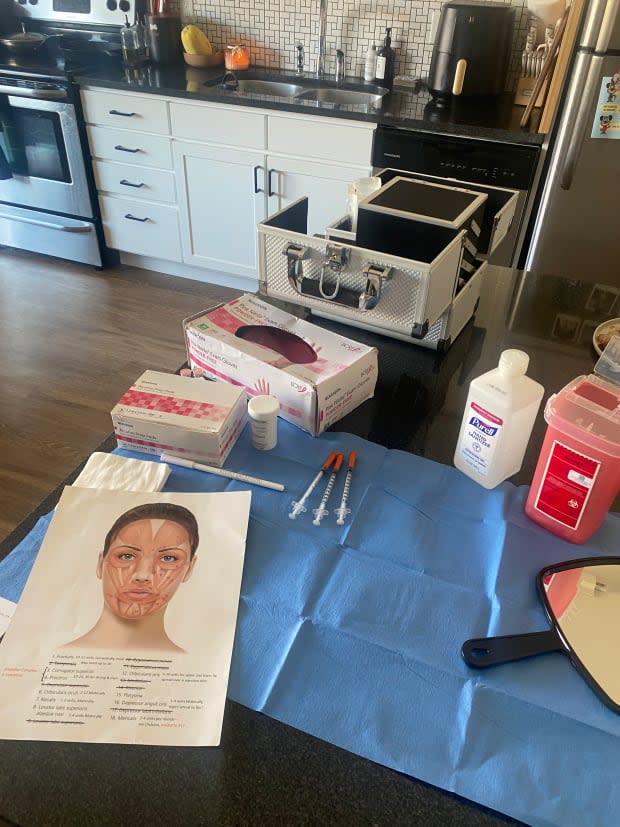At-Home Botox and Filler Are Going Mainstream
Here's what you need to know, from someone who tried it.
Alexandra Murphy, MMS, PA-C — a surgical and aesthetics physician assistant — was set to arrive at my apartment at 10 a.m. In preparation, I frantically sanitized my kitchen island and polished it until glossy, simultaneously ushering my fiancé out the door to pick up scones. You'd think I was hosting a mid-morning book club meeting, but this random Tuesday called for something else entirely: my first-ever Botox appointment, set to take place in my one-bedroom apartment.
For this experience, I entrusted The Skin Clique, a medspa company offering at-home services, including neuromodulator (a.k.a. "tox") injections, dermal filler and chemical peels. The business was born in South Carolina in 2018, founded by Dr. Sarah L. Allen and nurse practitioner Claire O'Bryan. Word of their joint venture began to take off in their small southern town and, ultimately, thousands of miles beyond. In the years since, it's become one of the first concierge medspa companies to mobilize nationwide, with providers across 31 states and counting.
Enter Murphy, a Twin Cities-based provider, who, in true Midwestern fashion, kept our appointment in the wake of a major snowstorm. She arrived right on time and — despite being accosted by my dog (for attention) and me (to eat the aforementioned scone; she declined) — was articulate and patient answering my rapid-fire questions: What will it feel like? Will I be able to move my face?
We started with a brief, yet comprehensive, facial anatomy lesson that was far more interesting than anything I'd learned in high school, followed by a lengthy consent form and a few "before" photos. Then, she gave me the low-down on the different brands of Botulinum toxins the company offers (Xeomin, Botox and Dysport); I proceeded with the former after picking her very-smart brain about its pros and cons.
Murphy marked up my face, and after I took some selfies (for journalism!), she injected a total of 30 units: 12 in my forehead, 10 in my glabellar lines (also known as "11s," which can appear between brows), and eight in my upper lip. (Consider me an official member of the lip flip club.) My fiancé let me squeeze his hand into oblivion with every poke and prod, a tolerable-yet-uncomfy sensation reminiscent of a bee sting.

The writer pre-injections; the at-home setup. Photos: Courtesy of writer

My decision to get injectables was trite: I wanted to get a head start on wrinkle prevention and have my skin looking its best for my fast-approaching wedding. I'm far from alone; medical aesthetics are booming as people seek solutions to look and feel their most confident. In 2022, the global market was valued at $13.9 billion, and trend forecasts anticipate it will reach a whopping $30.9 billion by 2030.
As for my decision to do it at home? A little more unique — but not much. I was undeniably intrigued by a growing trend of modernized medspa companies advertising safety, regulation and convenience. They follow in the footsteps of in-home beauty services like Glamsquad and Priv, and, as implied, they make a very compelling case for getting Botox, filler, you name it — without having to take off your slippers.
Plus, it seems like everyone's doing it — Botox and filler, that is. Cosmetic treatments have gone mainstream, especially among millennials and Gen Z. In turn, people have become more transparent — even eager — to speak about the aesthetic procedures they've undergone. Just look at TikTok, where content creators have documented their medspa appointments as intimately as possible; it's the ultimate symbol of transparency in the influencer space.
Among them is Bailey Nomi. In January, the 33-year-old TikToker and Nomi Active founder posted a video getting injections from her chic couch, clad in a cozy monochrome sweat set. "I started getting Botox at home because I get anxious visiting doctors' offices," she tells Fashionista. "I find them really sterile, I hate the lighting, and I don't like how I feel when I'm there."
View the original article to see embedded media.
Comfort — and convenience — are top priorities for Dr. Evan Blum, founder and medical director of The Aesthetics Concierge in Charlotte, North Carolina. "We work on the patient's time, when they want and where they want, be it at the office, their home, with the kids running around, or in between activities," he says. "When I can go to somebody's house, offer them something they'd normally be hesitant to get or not be able to afford, and pass it onto them, it's a win-win."
Affordability is an important point: The average cost of in-office Botulinum toxin injections is $466, according to the most recent statistics from the American Society of Plastic Surgeons, and at-home treatments are seemingly competitive, despite how fancy it sounds for a provider to drop by your doorstep. For context, my 30 units of Xeomin rang in at $400 flat ($13 per unit) — including the round-trip travel fee of $25. (The Aesthetics Concierge offers nearly identical unit pricing and a $20 travel fee.)
At-home medspa treatments might sound like the ultimate luxury, but above all, they're also medical procedures that shouldn't be taken lightly. As a concept, at-home injectables aren't safe unless they're highly regulated — which isn't always the case.
Are at-home aesthetics safe?
Let's rewind to the early days of at-home aesthetics. In 2002 — mere months after the FDA first approved Botox as a temporary cosmetic treatment — The New York Times deemed it the "year of the Botox party." For the unfamiliar, the controversial concept is exactly what it sounds like: a casual gathering where a medical provider administers injectables to attendees.
These parties became an "instant hit," says Dr. Samantha Ellison, a freelance hospitalist physician who does Botox parties as a side gig. They "blend convenience, privacy and fun in a less-formal setting," but require a highly skilled and trusted provider. "Only providers who are trained appropriately should be performing these procedures in any setting, especially on a concierge basis," she adds.
Board-certified dermatologist Dr. Karan Lal poses safety concerns because he's seen his fair share of horror stories. "I've seen a lady injected with carboxymethylcellulose [aka, cellulose gum, a food thickening agent] in her face at one of these at-home parties and got infectious nodules," says Dr. Lal. And this wasn't an out-of-the-blue occurrence, either. "People are getting injected with car sealant, silicone and plastic materials," he continues, emphasizing that derms like himself are tasked with handling at-home aesthetics complications "all the time."
Mona Khan, a 42-year-old mental health professional, knows this all too well. In 2014, she attended a Botox party hosted by one of her colleagues, in this instance, a psychiatrist. This gatherings happened frequently, but Khan typically only attended — and occasionally hosted — to socialize with her coworkers, opting not to be injected herself. But one evening, after everyone had left one of their gatherings, she had a change of heart, albeit without much introspection.
"[The practitioner] was like, 'do you want me to put it in your face?' And I hadn't given it much thought, but I was like, 'you know what, why not?' She marked me up, and everything seemed official," recalls Khan. But, days later, instead of noticing the face-smoothing effects neurotoxins are known for, she developed ptosis, a rare side effect causing a droopy eyelid that can happen when neurotoxin is injected into the wrong area.
Khan's parties never involved alcohol, but Botox parties and cocktails tend to go hand-in-hand, which is dangerous territory, both medically and legally. Drinking increases your chances of post-injection bleeding, bruising and swelling, and once you have some alcohol in your system, the provider "can't verify someone's consent," says Dr. Lal. In other words: It's illegal.
Cleanliness is a concern, too. "The office environment creates and allows a clean, sterile environment," says Dr. Kami Parsa, a Beverly Hills-based plastic surgeon. An unclean home poses a greater risk of infection, since it's an uncontrolled environment. In hindsight, Khan says she'd never get injectables in a "casual place" again. "I'm just thinking about how filthy my house must have been, she admits. "I had, like, three rabbits running around."
All these factors have made Botox parties, and at-home aesthetics in general, controversial and even illegal in some states: Connecticut banned at-home practices in 2014, and Nevada followed suit in 2017. Both require that cosmetic neurotoxins be administered at a medical spa or licensed healthcare facility.
Once you leave the office setting, it's safe to assume that "anything goes," warns Dr. Lal. That said, "it's your duty as a patient to look at the practice or provider, ask about malpractice insurance, how many complications they've had, and what their training is, plus to see their training certificates."
The future of at-home aesthetics
Patients aren't the only ones reveling in the at-home aesthetics boom; providers are, too — namely for the flexible schedule and a refreshed patient-provider experience. "I can have a conversation with people and treat them as individuals rather than a patient out of 50 that I have to get done in a five-minute spot," says Dr. Blum. "The old-fashioned notion of sitting in the waiting room for 45 minutes to have a quick appointment with your doc is the opposite of what we're trying to do."
Dr. Blum says the "bulk of his business" is busy parents — usually moms — which Dr. Allen implies is the case with her company, too. "Many people feel guilty taking the time away from work or their children to drive to an office and sit in a waiting room," The Skin Clique co-founder explains. "We've seen that they want to connect with their provider." And above all: "They want their time back," she says.
View the original article to see embedded media.
Still, critical work must be done to standardize the at-home aesthetics practice. "We have an ethical responsibility to ensure that the industry grows safely for patients," says Dr. Allen, who only hires physicians, nurse practitioners and physician assistants trained under a physician. Likewise, the company requires "over 20 hours, plus a capstone event where patients and providers come for hands-on training." The Skin Clique claims its complication rate is "less than 0.0005%."
Even at the highest standard of care, not all providers can get behind the at-home aesthetics boom. Dr. Lal is among them, and he's unwavering in his perspective that such procedures should be exclusive to an office setting. He underscores his point in arguably the most dramatic way possible: "If Beyoncé called me to come to her house for a treatment, I'm not going to do it," he says, adding, "and you can quote me on that."
Others are thrilled to see that the field of concierge aesthetics is evolving and democratizing. While aesthetics providers may have formerly reserved house calls for A-listers with a penchant for privacy, it's not-so-quietly turning into a more accessible alternative for the masses. Ellison says her client base comprises people "from all walks of life and experiences," from celebrities and politicians to aesthetics-curious individuals like moi.
It's now been more than a month since my at-home appointment. My 'tox has settled perfectly; the results are subtle, yet effective: My lips appear slightly fuller, yet natural, and my forehead and '11' lines are relaxed, but not frozen. But it can't be stressed enough that this is the best-case scenario and, unfortunately, not everyone's reality. It's common sense to research and treat at-home aesthetics with the same level of seriousness as an in-office procedure. Ultimately it's the same thing, just a hell of a lot comfier.
Never miss the latest fashion industry news. Sign up for the Fashionista daily newsletter.
